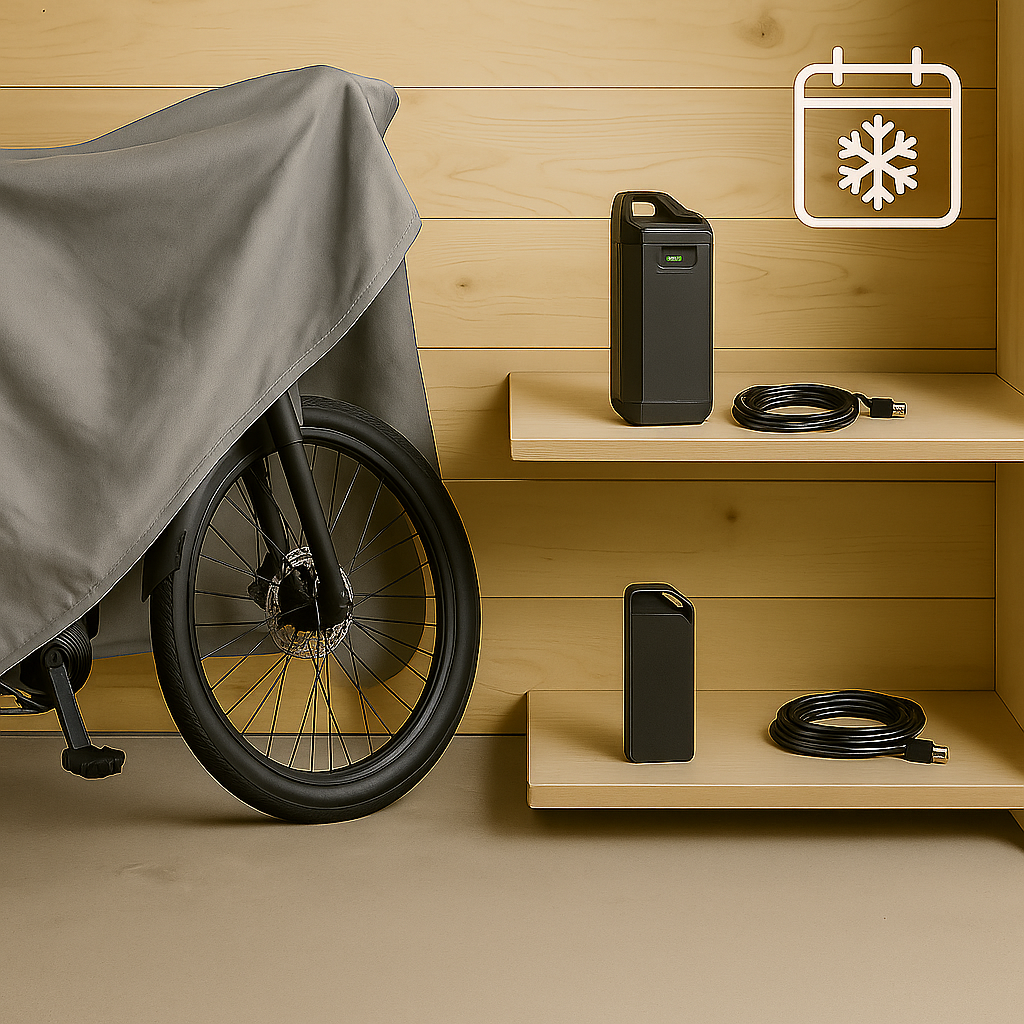As the days grow shorter and the crisp autumn air turns into winter's chill, many e-bike riders start thinking about putting their trusty steed away until spring. Proper winter storage is crucial, especially for your e-bike's delicate electronics and, most importantly, its battery. Neglecting these steps can lead to a less-than-optimale-bike come spring, or even costly replacements.
Think of it as putting your e-bike into a cozy hibernation. By following a few simple, common-sense steps, you can ensure your e-bike and its charger emerge from the winter months refreshed, ready for many more miles of adventures. Let's make sure your ride stays in tip-top shape through the cold!
Step 1: Give Your E-Bike a Deep Clean
Before tucking your e-bike away for its long winter nap, a thorough cleaning is in order. Dirt, mud, salt, and grime left on your bike can cause corrosion and wear over time, turning small issues into bigger problems.
- Wash It Down: Use a bucket of lukewarm water, a soft sponge, and bike-specific cleaner (avoid harsh detergents). Gently clean the frame, wheels, and especially the drivetrain (chain, gears, derailleur). Be careful around electrical components and never use a high-pressure washer directly on them.
- Dry Thoroughly: Once clean, make sure every part of your e-bike is completely dry. Use a clean, dry cloth. Pay extra attention to electrical contact points for the battery and motor.
- Lube the Chain: After drying, apply a fresh layer of chain lubricant to prevent rust and keep your drivetrain running smoothly.
Step 2: The Most Important Part – Your E-Bike Battery!
Your e-bike battery is the heart of your bike, and it's the most sensitive component to improper storage. Taking care of it correctly is key to its longevity.
Get the Charge Level Right
This is one of the most vital steps. Lithium-ion batteries (which nearly all e-bikes use) do not like to be stored completely empty or completely full for long periods.
- The Sweet Spot: Charge your battery to somewhere between 40% and 80% before storing it. Many experts recommend around 60%. This range puts the least stress on the battery cells.
- Avoid Extremes: Never store a battery at 0% (which can lead to "deep discharge" and permanent damage) or 100% (which can accelerate capacity loss over time).
Choose the Right Storage Location for Your Battery
Temperature and humidity are your battery's biggest enemies during storage.
- Bring It Inside: Always remove your battery from the e-bike and bring it indoors. Your unheated garage or shed might be fine for the bike frame, but it's likely too cold for the battery.
- Room Temperature is Key: Store your battery in a cool, dry place where the temperature stays relatively stable, ideally between 50°F and 77°F (10°C and 25°C). A closet, shelf in a heated room, or even a dedicated battery storage box in your living space works perfectly.
- Avoid Humidity and Sunlight: Keep it away from damp basements, direct sunlight, heat sources (like radiators), and open windows where condensation could form.
Don't Forget Periodic Check-Ins
Batteries naturally lose a tiny bit of charge over time (called self-discharge).
- Monthly Check: Every 1 to 3 months, quickly check your battery's charge level. If it's dropped below your ideal storage range (e.g., below 40%), plug it in with your correct charger and bring it back up to that 40-80% sweet spot. Then, unplug it again.
Step 3: Storing Your E-Bike Frame and Components
Once the battery is safely tucked away, it's time to find a good spot for the rest of your e-bike.
- Cool, Dry, and Frost-Free: A garage, a shed (if it stays above freezing), or a basement are common choices. The most important thing is that it's dry and protected from extreme cold or dampness, which can damage electrical components, wiring, and cause rust on mechanical parts.
- Inflate Tires: Pump your tires up to their recommended pressure. This helps prevent flat spots from forming when the bike sits for a long time.
- Cover It Up: Use a breathable bike cover (not a sealed plastic bag that can trap moisture) to protect your e-bike from dust and dirt during storage.
- Security: Wherever you store your bike, make sure it's secure. Consider a good lock, even indoors, especially if your garage is accessible.
- Positioning: Store your bike upright. If you plan to hang it, ensure the hanger can support the e-bike's heavier weight, and avoid hanging it by a single wheel for very long periods, which could stress the rim.
Step 4: Don't Forget Your Charger!
Your e-bike charger also needs a little love and proper storage.
- Clean and Store: Wipe down your charger and its cables with a dry cloth. Check for any signs of wear or damage.
- Similar Conditions: Store your charger in the same kind of environment as your battery – dry, room temperature, and away from extreme heat or cold.
Conclusion: Ready for Spring Adventures
Winter storage might seem like a chore, but these few simple steps will make a world of difference. By properly caring for your e-bike and its battery during the off-season, you're not just preserving its value; you're ensuring that when spring arrives, your e-bike is ready to roll at a moment's notice, offering you dependable performance and countless enjoyable rides. Happy hibernation!


Share:
Real Stories: How Riders Transformed Their Commutes with Cyberpika
The Future of E-Bike Charging Technology: What's Next for Your Ride?